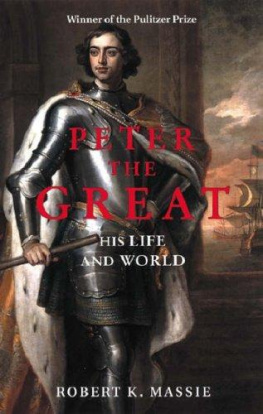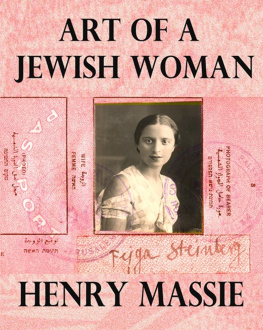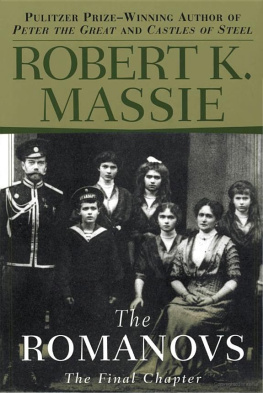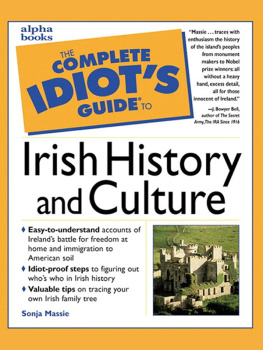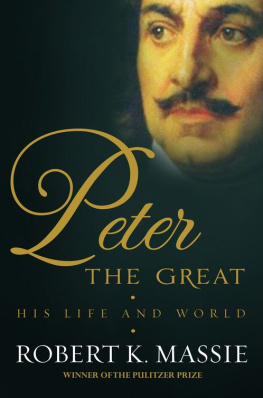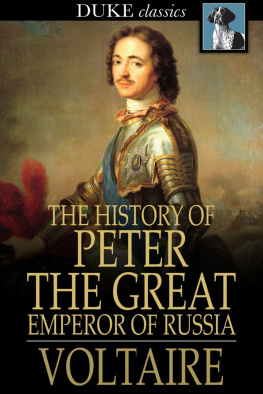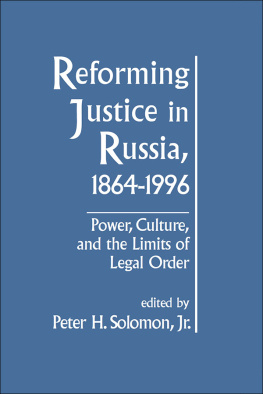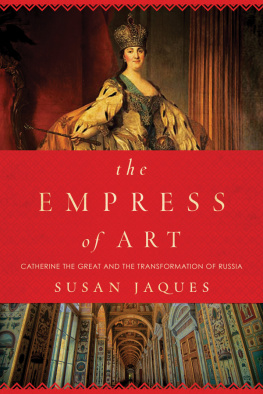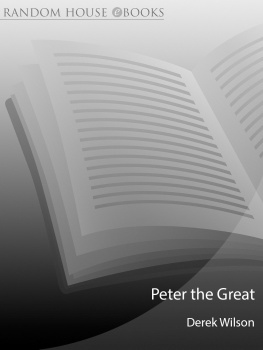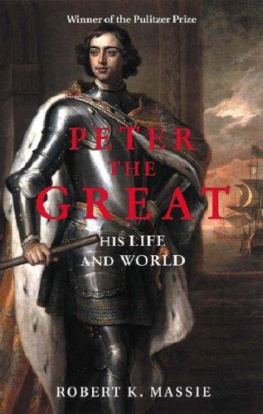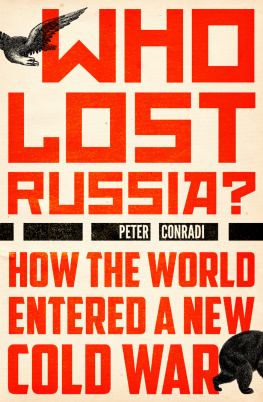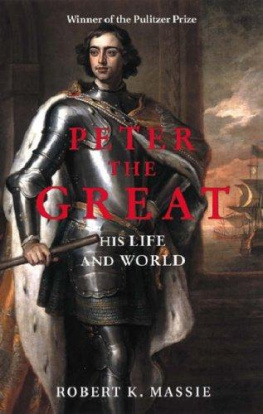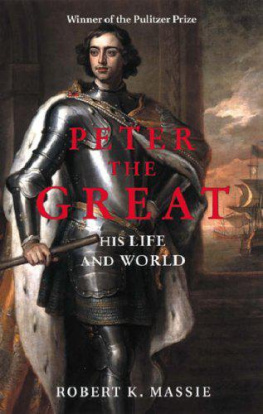Massie - Peter the Great: His Life and World
Here you can read online Massie - Peter the Great: His Life and World full text of the book (entire story) in english for free. Download pdf and epub, get meaning, cover and reviews about this ebook. year: 1980, publisher: Weidenfeld & Nicholson history, genre: Non-fiction. Description of the work, (preface) as well as reviews are available. Best literature library LitArk.com created for fans of good reading and offers a wide selection of genres:
Romance novel
Science fiction
Adventure
Detective
Science
History
Home and family
Prose
Art
Politics
Computer
Non-fiction
Religion
Business
Children
Humor
Choose a favorite category and find really read worthwhile books. Enjoy immersion in the world of imagination, feel the emotions of the characters or learn something new for yourself, make an fascinating discovery.
- Book:Peter the Great: His Life and World
- Author:
- Publisher:Weidenfeld & Nicholson history
- Genre:
- Year:1980
- Rating:5 / 5
- Favourites:Add to favourites
- Your mark:
- 100
- 1
- 2
- 3
- 4
- 5
Peter the Great: His Life and World: summary, description and annotation
We offer to read an annotation, description, summary or preface (depends on what the author of the book "Peter the Great: His Life and World" wrote himself). If you haven't found the necessary information about the book — write in the comments, we will try to find it.
Enthralling...As fascinating as any novel and more so than most!THE NEW YORK TIMES BOOK REVIEWAgainst the monumental canvas of seventeenth- and eighteenth-century Europe and Russia, unfolds the magnificent story of Peter the Great. He brought Russia from the darkness of its own Middle Ages into the Enlightenment and transformed it into the power that has its legacy in the Russia of our own century.
Massie: author's other books
Who wrote Peter the Great: His Life and World? Find out the surname, the name of the author of the book and a list of all author's works by series.
Peter the Great: His Life and World — read online for free the complete book (whole text) full work
Below is the text of the book, divided by pages. System saving the place of the last page read, allows you to conveniently read the book "Peter the Great: His Life and World" online for free, without having to search again every time where you left off. Put a bookmark, and you can go to the page where you finished reading at any time.
Font size:
Interval:
Bookmark:
SUMMARY:
"Enthralling...As fascinating as any novel and more so than most!"THE NEW YORK TIMES BOOK REVIEWAgainst the monumental canvas of seventeenth- and eighteenth-century Europe and Russia, unfolds the magnificent story of Peter the Great. He brought Russia from the darkness of its own Middle Ages into the Enlightenment and transformed it into the power that has its legacy in the Russia of our own century.
PETER THE GREAT
His Life and World
Robert K. Massie
BALLANTINE BOOKS NEW YORK
Copyright 1980 by Robert K. Massie
Cover art property of NBC. 1985 National Broadcasting
Company, Inc. All Rights Reserved.
All rights reserved under International and Pan-American Copyright Conventions. Published in the United States of America by Ballantine Books, a division of Random House, Inc., New York, and simultaneously in Canada by Random House of Canada Limited, Toronto.
Library of Congress Catalog Card Number. 80-7635 ISBN 0-345-33619-4
This edition published by arrangement with Alfred A. Knopf, Inc.
Manufactured in the United States of America
First Ballantine Books Trade Edition: October 1981
First Ballantine Books Mass Market Edition: February 1986
For
Mary Kimball Todd and James Madison Todd and in memory of Robert Kinloch Mass i e
CONTENTS
Part One: Old Muscovy
Old Muscovy
Peter's Childhood
"A Maiden of Great Intelligence"
The Revolt of the Streltsy
The Great Schism
Peter's Games
The Regency of Sophia
Sophia Overthrown
Gordon, Lefort and the Jolly Company
Archangel
Azov
Part Two: The Great Embassy
The Great Embassy to Western Europe
"It Is Impossible to Describe Him"
Peter in Holland
The Prince of Orange
Peter in England
Leopold and Augustus
"These Things Are in Your Way"
Fire and Knout
Among Friends
Voronezh and the Southern Fleet
Part Three: The Great Northern War
Mistress of the North
Let the Cannon Decide
Charles XII
Narva
"We Must Not Lose Our Heads"
The Founding of St. Petersburg
Menshikov and Catherine
The Hand of the Autocrat
Polish Quagmire
Charles in Saxony
The Great Road to Moscow
Golovchin and Lesnaya
Mazeppa
The Worst Winter Within Memory
The Gathering of Forces
Poltava
Surrender by the River
The Fruits of Poltava
Part Four: On the European Stage
The Sultan's World
Liberator of the Balkan Christians
Fifty Blows on the Pruth
The German Campaign and Frederick William
The Coast of Finland
The Kalabalik
Venice of the North
An Ambassador Reports
The Second Journey West
"The King Is a Mighty Man..."
A Visitor in Paris
The Education of an Heir
A Paternal Ultimatum
Flight of the Tsarevich
The Future on Trial
Charles' Last Offensive
King George Enters the Baltic
Victory
Part Five: The New Russia
In the Service of the State
Commerce by Decree
Supreme Under God
The Emperor in St. Petersburg
Along the Caspian
Twilight
851 Epilogue
MAPS
Russia during the youth of Peter the Great, 1672-1696
Moscow
The Swedish Empire at the beginning of the
Great Northern War
The Battle of Narva I
The Battle of Narva II
The Swedish invasion of Russia, 1708-1709
Poltava I
Poltava II
Poltava III
Poltava IV
The Pnith campaign
Europe in the time of Peter the Great 936-937
PETER THE GREAT
His Life an d World
OLD MUSCOVY
Around Moscow, the country rolls gently up from the rivers winding in silvery loops across the pleasant landscape. Small lakes and patches of woods are sprinkled among the meadow-lands. Here and there, a village appears, topped by the onion dome of its church. People are walking through the fields on dirt paths lined with weeds. Along the riverbanks, they are fishing, swimming and lying in the sun. It is a familiar Russian scene, rooted in centuries.
In the third quarter of the seventeenth century, the traveler coming from Western Europe passed through this countryside to arrive at a vantage point known as the Sparrow Hills. Looking down on Moscow from this high ridge, he saw at his feet "the most rich and beautiful city in the world." Hundreds of golden domes topped by a forest of golden crosses rose above the treetops; if the traveler was present at a moment when the sun touched all this gold, the blaze of light forced his eyes to close. The white-walled churches beneath these domes were scattered through a city as large as London. At the center, on a modest hill, stood the citadel of the Kremlin, the glory of Moscow, with its three magnificent cathedrals, its mighty bell tower, its gorgeous palaces, chapels and hundreds of houses. Enclosed by great white walls, it was a city in itself.
In summer, immersed in greenery, the city seemed like an enormous garden. Many of the larger mansions were surrounded by orchards and parks, while swaths of open space left as firebreaks burst out with grasses, bushes and trees. Overflowing its own walls, the city expanded into numerous flourishing suburbs, each with its own orchards, gardens and copses of trees. Beyond, in a wide circle around the city, the manors and estates of great nobles and the white walls and gilded cupolas of monasteries were scattered among meadows and tilled fields to stretch the landscape out to the horizon.
Entering Moscow through its walls of earth and brick, the traveler plunged immediately into the bustling life of a busy commercial city. The streets were crowded with jostling humanity.
Tradespeople, artisans, idlers and ragged holy men walked beside laborers, peasants, black-robed priests and soldiers in bright-colored caftans and yellow boots. Carts and wagons struggled to make headway through this river of people, but the crowds parted for a fat-bellied, bearded boyar, or nobleman, on horseback, his head covered with a fine fur cap and his girth with a rich fur-lined coat of velvet or stiff brocade. At street corners, musicians, jugglers, acrobats and animal handlers with bears and dogs performed their tricks. Outside every church, beggars clustered and wailed for alms. In front of taverns, travelers were sometimes astonished to see naked men who had sold every stitch of clothing for a drink; on feast days, other men, naked and clothed alike, lay in rows in the mud, drunk.
The densest crowds gathered in the commercial districts centered on Red Square. The Red Square of the seventeenth century was very different from the silent, cobbled desert we know today beneath the fantastic, clustered steeples and cupolas of St. Basil's Cathedral and the high Kremlin walls. Then it was a brawling, open-air marketplace, with logs laid down to cover the mud, with lines of log houses and small chapels built against the Kremlin wall where Lenin's tomb now stands, and with rows and rows of shops and stalls, some wood, some covered by tent-like canvas, crammed into every corner of the vast arena. Three hundred years ago. Red Square teemed, swirled and reverberated with life. Merchants standing in front of stalls shouted to customers to step up and inspect their wares. They offered velvet and brocade, Persian and Armenian silk, bronze, brass and copper goods, iron wares, tooled leather, pottery, innumerable objects made of wood, and rows of melons, apples, pears, cherries, plums, carrots, cucumbers, onions, garlic and asparagus as thick as a thumb, laid out in trays and baskets. Peddlers and pushcart men forced their way through the crowds with a combination of threats and pleas. Vendors sold pirozhki (small meat pies) from trays suspended by cords from their shoulders. Tailors and street jewelers, oblivious to all around them, worked at their trades. Barbers clipped hair, which fell to the ground unswept, adding a new layer to a matted carpet decades in the forming. Flea markets offered old clothes, rags, used furniture and junk. Down the hill, nearer the Moscow River, animals were sold, and live fish from tanks. On the riverbank itself, near the new stone bridge, rows of women bent over the water washing clothes. One seventeenth-century German traveler noted that some of the women selling goods in the square might also sell "another commodity."
Font size:
Interval:
Bookmark:
Similar books «Peter the Great: His Life and World»
Look at similar books to Peter the Great: His Life and World. We have selected literature similar in name and meaning in the hope of providing readers with more options to find new, interesting, not yet read works.
Discussion, reviews of the book Peter the Great: His Life and World and just readers' own opinions. Leave your comments, write what you think about the work, its meaning or the main characters. Specify what exactly you liked and what you didn't like, and why you think so.

